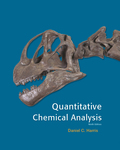
Concept explainers
(a)
Interpretation:
For given equilibria,
The equilibrium constant (K) for given reaction has to be calculated.
Concept introduction:
Equilibrium constant (K): In the equilibrium reaction, the ratio of concentration of the reactant and concentration of the product. If value of K is small than 1 the reaction should be move to the left and k is more than 1 the reaction should be move to right.
(a)
Answer to Problem 6.AE
The equilibrium constant (K) for given reaction is
Explanation of Solution
Given
By adding these two equilibria and multiply these equilibrium constant we can get equilibrium constant and given chemical equation.
(b)
Interpretation:
For given equilibria,
The concentration of aqueous
Concept introduction:
Equilibrium constant (K): In the equilibrium reaction, the ratio of concentration of the reactant and concentration of the product. If value of K is small than 1 the reaction should be move to the left and k is more than 1 the reaction should be move to right.
When reaction attains equilibrium, the association between concentration of reactant and product are defined by equilibrium constant.
(b)
Answer to Problem 6.AE
The concentration of aqueous
Explanation of Solution
Given
By adding these two equilibria and multiply these equilibrium constant we can get equilibrium constant and given chemical equation.
When reaction attains equilibrium, the association between concentration of reactant and product are defined by equilibrium constant. Hence, the concentration will be the same as equilibrium constant.
Thus, the concentration of aqueous
(c)
Interpretation:
For given reaction equilibrium constant has to be calculated.
Concept introduction:
Equilibrium constant (K): In the equilibrium reaction, the ratio of concentration of the reactant and concentration of the product. If value of K is small than 1 the reaction should be move to the left and k is more than 1 the reaction should be move to right.
(c)
Answer to Problem 6.AE
The equilibrium constant (K) for given reaction is
Explanation of Solution
Given
By adding these two equilibria and multiply these equilibrium constant we can get equilibrium constant and given chemical equation.
If the reaction is reversed, K =
Want to see more full solutions like this?
Chapter 6 Solutions
Quantitative Chemical Analysis
 ChemistryChemistryISBN:9781305957404Author:Steven S. Zumdahl, Susan A. Zumdahl, Donald J. DeCostePublisher:Cengage Learning
ChemistryChemistryISBN:9781305957404Author:Steven S. Zumdahl, Susan A. Zumdahl, Donald J. DeCostePublisher:Cengage Learning ChemistryChemistryISBN:9781259911156Author:Raymond Chang Dr., Jason Overby ProfessorPublisher:McGraw-Hill Education
ChemistryChemistryISBN:9781259911156Author:Raymond Chang Dr., Jason Overby ProfessorPublisher:McGraw-Hill Education Principles of Instrumental AnalysisChemistryISBN:9781305577213Author:Douglas A. Skoog, F. James Holler, Stanley R. CrouchPublisher:Cengage Learning
Principles of Instrumental AnalysisChemistryISBN:9781305577213Author:Douglas A. Skoog, F. James Holler, Stanley R. CrouchPublisher:Cengage Learning Organic ChemistryChemistryISBN:9780078021558Author:Janice Gorzynski Smith Dr.Publisher:McGraw-Hill Education
Organic ChemistryChemistryISBN:9780078021558Author:Janice Gorzynski Smith Dr.Publisher:McGraw-Hill Education Chemistry: Principles and ReactionsChemistryISBN:9781305079373Author:William L. Masterton, Cecile N. HurleyPublisher:Cengage Learning
Chemistry: Principles and ReactionsChemistryISBN:9781305079373Author:William L. Masterton, Cecile N. HurleyPublisher:Cengage Learning Elementary Principles of Chemical Processes, Bind...ChemistryISBN:9781118431221Author:Richard M. Felder, Ronald W. Rousseau, Lisa G. BullardPublisher:WILEY
Elementary Principles of Chemical Processes, Bind...ChemistryISBN:9781118431221Author:Richard M. Felder, Ronald W. Rousseau, Lisa G. BullardPublisher:WILEY





